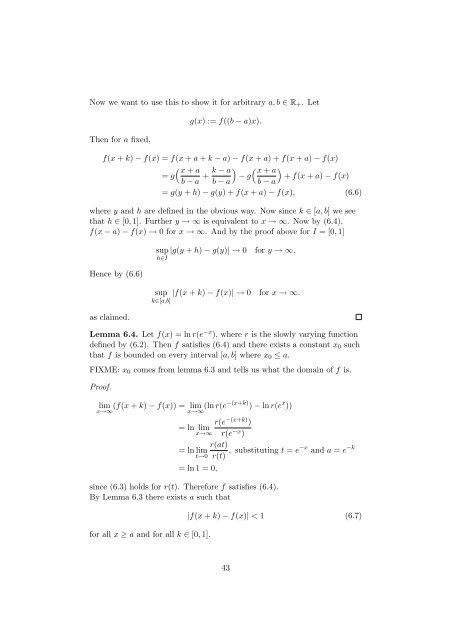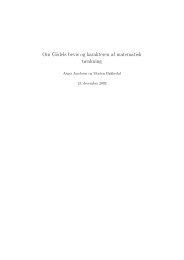Master Dissertation
Master Dissertation
Master Dissertation
Create successful ePaper yourself
Turn your PDF publications into a flip-book with our unique Google optimized e-Paper software.
Now we want to use this to show it for arbitrary a, b ∈ R+. Let<br />
Then for a fixed,<br />
g(x) := f((b − a)x).<br />
f(x + k) − f(x) = f(x + a + k − a) − f(x + a) + f(x + a) − f(x)<br />
<br />
x + a k − a<br />
<br />
x + a<br />
<br />
= g + − g + f(x + a) − f(x)<br />
b − a b − a b − a<br />
= g(y + h) − g(y) + f(x + a) − f(x), (6.6)<br />
where y and h are defined in the obvious way. Now since k ∈ [a, b] we see<br />
that h ∈ [0, 1]. Further y → ∞ is equivalent to x → ∞. Now by (6.4),<br />
f(x − a) − f(x) → 0 for x → ∞. And by the proof above for I = [0, 1]<br />
Hence by (6.6)<br />
as claimed.<br />
sup |g(y + h) − g(y)| → 0 for y → ∞.<br />
h∈I<br />
sup<br />
k∈[a,b]<br />
|f(x + k) − f(x)| → 0 for x → ∞.<br />
Lemma 6.4. Let f(x) = ln r(e −x ), where r is the slowly varying function<br />
defined by (6.2). Then f satisfies (6.4) and there exists a constant x0 such<br />
that f is bounded on every interval [a, b] where x0 ≤ a.<br />
FIXME: x0 comes from lemma 6.3 and tells us what the domain of f is.<br />
Proof.<br />
lim (f(x + k) − f(x)) = lim<br />
x→∞ x→∞ (ln r(e−(x+k) ) − ln r(e x ))<br />
r(e<br />
= ln lim<br />
x→∞<br />
−(x+k) )<br />
= ln lim<br />
t→0<br />
= ln 1 = 0,<br />
r(e −x )<br />
since (6.3) holds for r(t). Therefore f satisfies (6.4).<br />
By Lemma 6.3 there exists a such that<br />
for all x ≥ a and for all k ∈ [0, 1].<br />
r(at)<br />
r(t) , substituting t = e−x and a = e −k<br />
|f(x + k) − f(x)| < 1 (6.7)<br />
43



